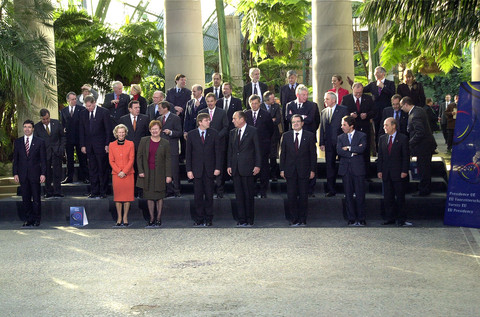[ad_1]
Guy Verhofstadt MEP was Belgian prime minister from 1999 until 2008, the period that started with the Treaty of Nice and ended with the Treaty of Lisbon.
In between, in 2001, under his leadership, the Belgian presidency of the EU launched the Laeken Declaration which set in train the European Convention, chaired by France’s Valérie Giscard d’Estaing.
The goal was to write a European Constitution. When that constitution was voted down in the referenda in France and the Netherlands in 2005, the constitution was stripped of its constitutional elements, and became the Treaty of Lisbon.
“The idea of creating a European Convention with the mission of writing a European Constitution was born during the discussions in Nice in 2000,” Verhofstadt says.
“We all realised that too many files were blocked by rigid decision procedures. There was also a lack of clarity on the competences of the EU.”
“The European leaders decided to install a weighing of votes per country and the principle of subsidiarity, where countries could flag when they thought the EU was going beyond its competences. But in the last article of the treaty, we wrote that Europe needed a convention to give the EU a constitutional law.”
The declaration of Laeken launched the European Convention, with former French president Giscard d’Estaing as its chair and Giuliano Amato, former Italian prime minister, and Jean-Luc Dehaene, former Belgian prime minister, as deputy chairs.
“What we did in the declaration of Laeken was to formulate the problems that needed to be solved in a new treaty in the format of questions,” Verhofstadt recalls. “For example, we asked what the role was of the European Parliament, or the role of the regions?”
“In the 1950s the European members states made a constitution, but it was voted away by the French Assembly. Now we wanted to give it another try, with all constitutional elements included, like a European flag and an anthem.”
According to Verhofstadt, Giscard d’Estaing did a great job – but also followed his own agenda.
“Giscard started with the German chancellor Helmut Schmidt informal leaders’ summits to discuss world politics. In the convention he made of the European Council a real institution.”
However, the constitution was rejected in referenda in both France and three days later in the Netherlands. That was the end of the constitution – and the beginning of the road to the Lisbon Treaty.
“Both referenda weren’t about the constitution,” Verhofstadt says.
“In France, it became a referendum on Jacques Chirac, with a part of the socialists campaigning against. In the Netherlands, it was about the cost of the EU and whether the Netherlands paid too much – something some Dutch politicians have been repeating for 10 years.”
EU leaders found a consensus on the text, after stripping its constitutional symbols.
It was no longer a European Constitution but the Treaty of Lisbon – on which no referendum was needed.
Yet just after the Treaty of Lisbon was signed in 2007, a global financial and economic crisis shook the world and cut deeply into Europe.
“The biggest weakness of the Lisbon Treaty is that is was agreed upon just before the financial and economic crisis,” Verhofstadt says.
“That’s why social and economic issues are not addressed. For this reason, the EU was incapable of addressing the crisis properly. Remember that one Eurosceptic party in the Finnish government blocked the decision to grant Greece the money they needed.”
With the current Covid-19 crisis the EU reacted differently and decided to issue bonds for €750bn in order to finance a recovery package.
“Europe has learned something from the Covid crisis,” Verhofstadt says. “More and more people realise that we can only deal with this kind of challenges on a European level.”
In the meantime, European leaders launched the Conference on the Future of Europe. The European Parliament wants Verhofstadt to chair it, but some EU leaders do not agree.
“There are still some issues that complicate European decision-making,” Verhofstadt says. “Look at the EU paralysis on Belarus, because of the need of unanimity in foreign affairs, or on migration.”
“There is still a lot to be done”, Verhofstadt concludes, “and the European reaction to the Covid crisis proves that it is possible.”
[ad_2]
Source link
